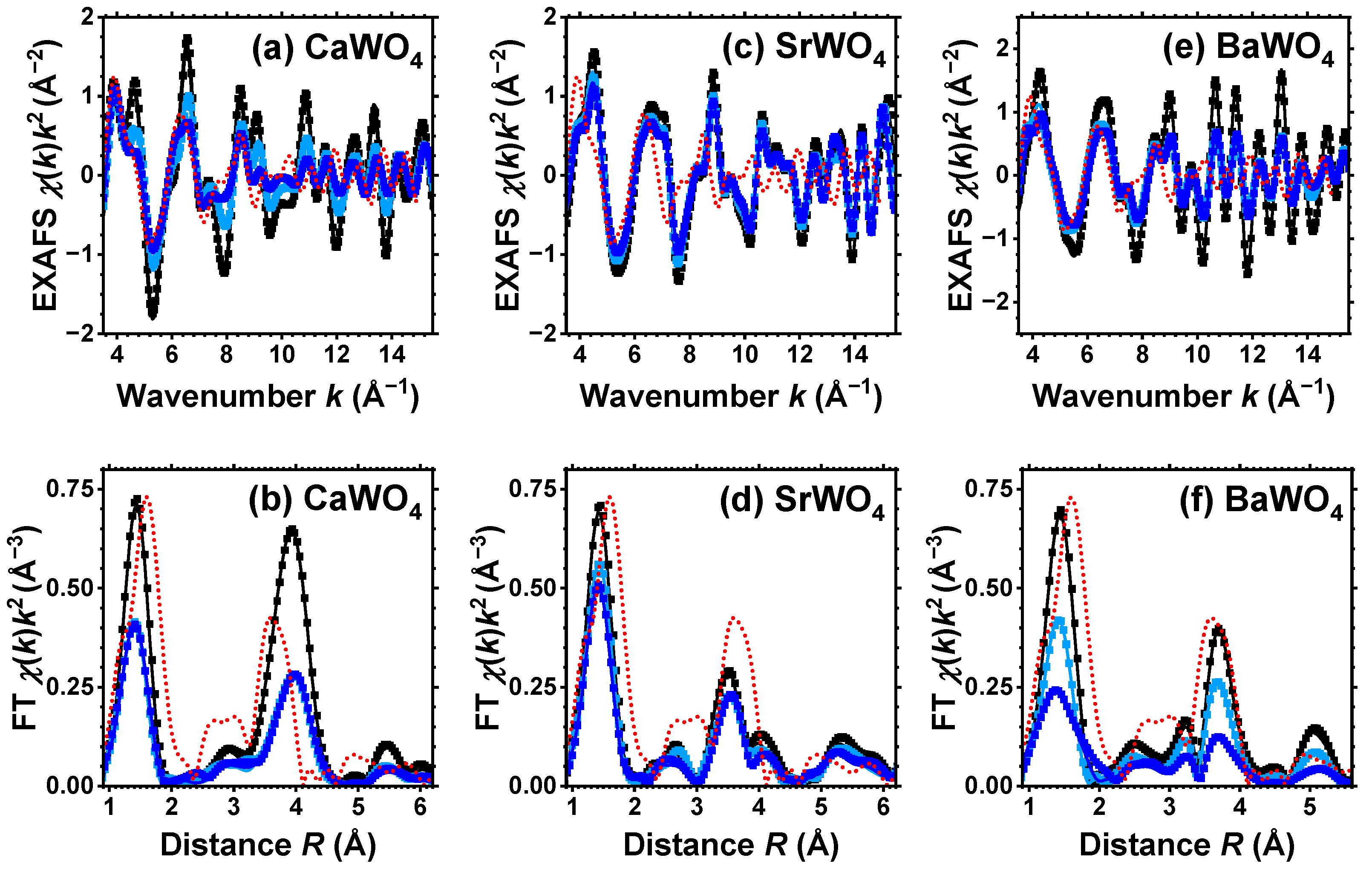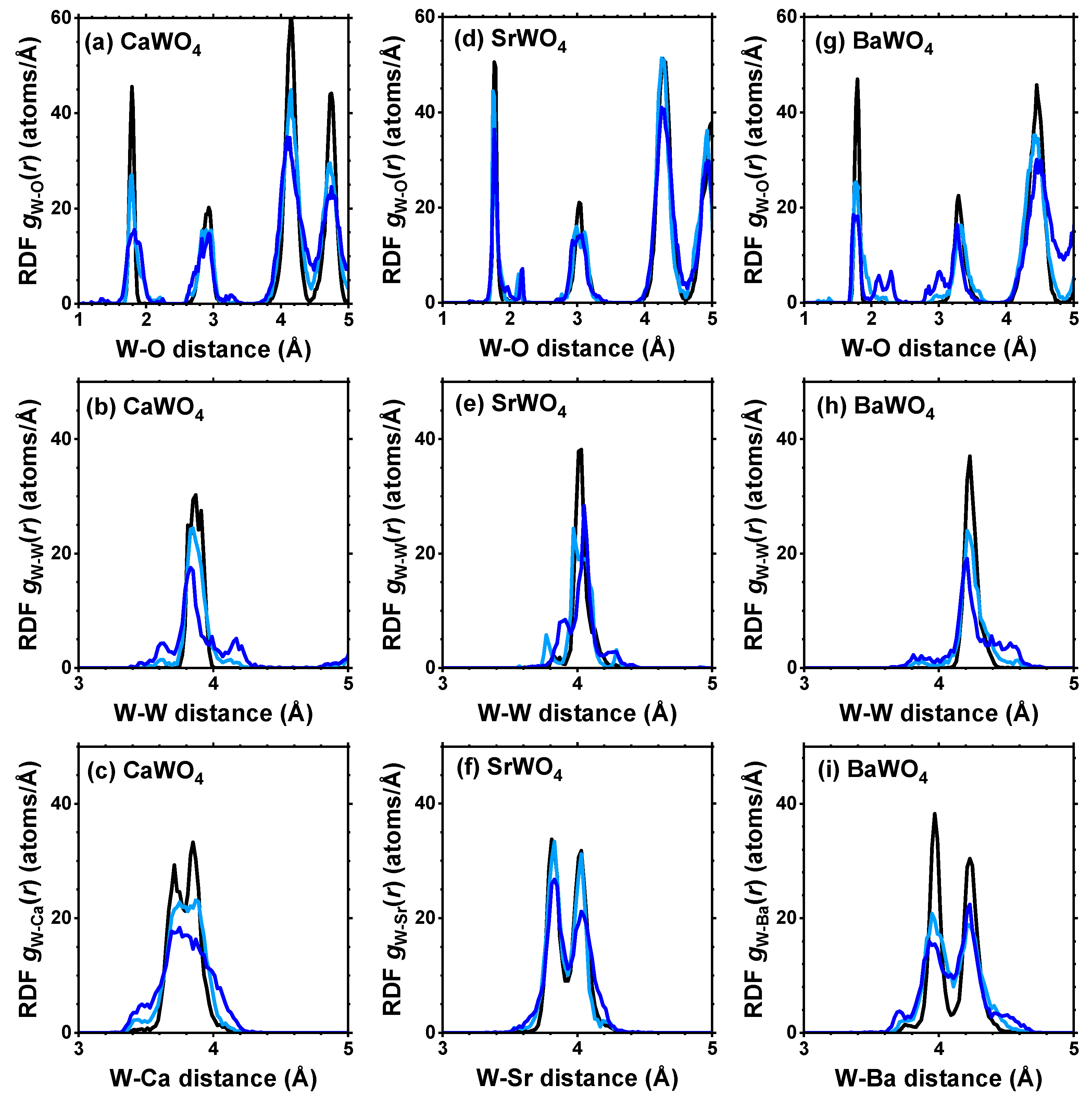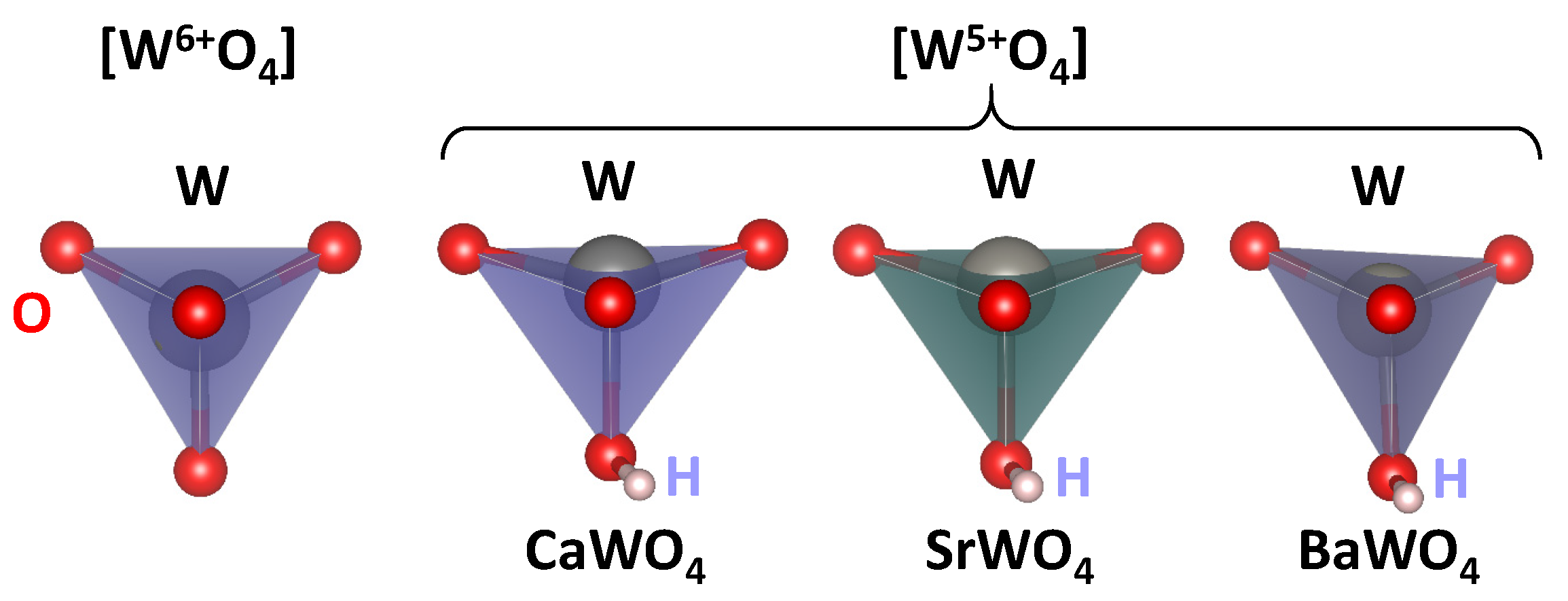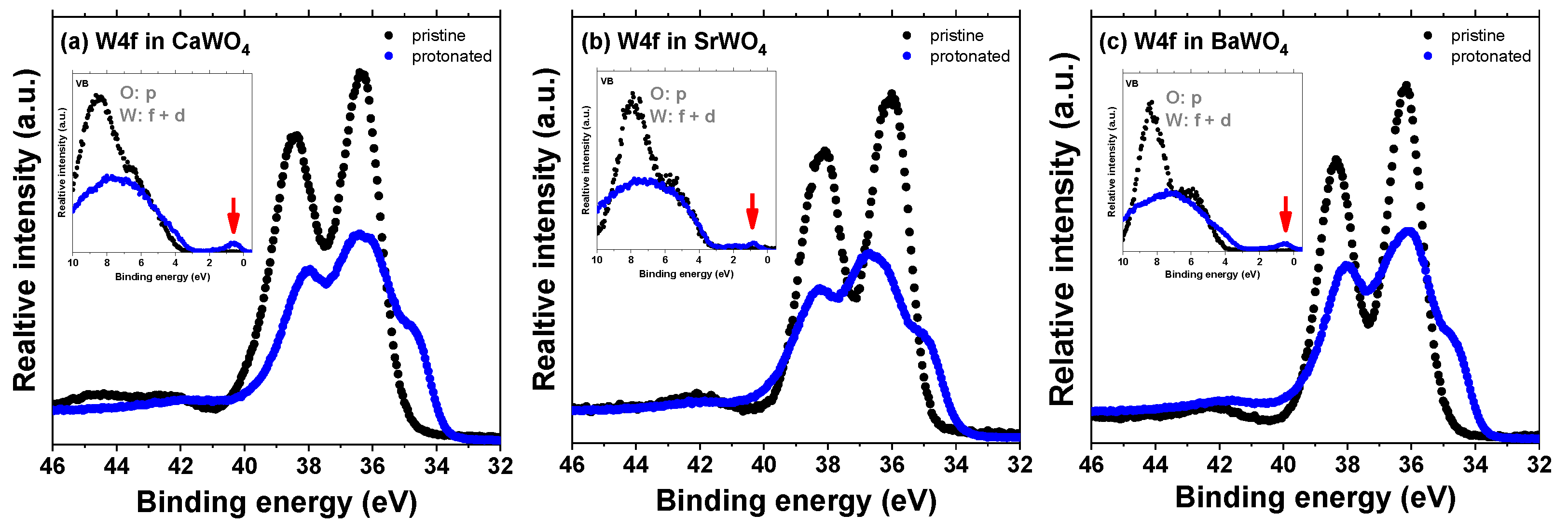Structure of Polaronic Centers in Proton-Intercalated AWO4 Scheelite-Type Tungstates
Abstract
1. Introduction
2. Materials and Methods
2.1. Sample Synthesis and Characterization
2.2. X-ray Absorption Spectroscopy and Data Analysis
2.3. First-Principles DFT Calculations
3. Results and Discussion
4. Conclusions
Author Contributions
Funding
Data Availability Statement
Acknowledgments
Conflicts of Interest
Abbreviations
| ADF | angular distribution function |
| CA | configuration-averaged |
| DFT | density functional theory |
| DOS | density of states |
| EA | evolutionary algorithm |
| EXAFS | extended X-ray absorption fine structure |
| FT | Fourier transform |
| LCAO | linear combination of atomic orbitals |
| MS | multiple-scattering |
| MT | muffin-tin |
| RDF | radial distribution function |
| RMC | reverse Monte Carlo |
| WT | wavelet transform |
| XAS | X-ray absorption spectroscopy |
| XPS | X-ray photoelectron spectroscopy |
| XRD | X-ray diffraction |
References
- Austin, I.; Mott, N. Polarons in crystalline and non-crystalline materials. Adv. Phys. 1969, 18, 41–102. [Google Scholar] [CrossRef]
- Ederth, J.; Hoel, A.; Niklasson, G.A.; Granqvist, C.G. Small polaron formation in porous WO3-x nanoparticle films. J. Appl. Phys. 2004, 96, 5722–5726. [Google Scholar] [CrossRef]
- Rettie, A.J.E.; Chemelewski, W.D.; Emin, D.; Mullins, C.B. Unravelling small-polaron transport in metal oxide photoelectrodes. J. Phys. Chem. Lett. 2016, 7, 471–479. [Google Scholar] [CrossRef]
- Franchini, C.; Reticcioli, M.; Setvin, M.; Diebold, U. Polarons in materials. Nat. Rev. Mater. 2021, 6, 560–586. [Google Scholar] [CrossRef]
- Landau, L.D. Electron motion in crystal lattices. Phys. Z. Sowjetunion 1933, 3, 664. [Google Scholar]
- Deb, S.K. Opportunities and challenges in science and technology of WO3 for electrochromic and related applications. Sol. Energy Mater. Sol. Cells 2008, 92, 245–258. [Google Scholar] [CrossRef]
- Granqvist, C. Electrochromic oxides: A unified view. Solid State Ion. 1994, 70–71, 678–685. [Google Scholar] [CrossRef]
- Niklasson, G.A.; Granqvist, C.G. Electrochromics for smart windows: Thin films of tungsten oxide and nickel oxide, and devices based on these. J. Mater. Chem. 2007, 17, 127–156. [Google Scholar] [CrossRef]
- Mortimer, R.J. Electrochromic materials. Annu. Rev. Mater. Res. 2011, 41, 241–268. [Google Scholar] [CrossRef]
- Kumar, R.; Pathak, D.K.; Chaudhary, A. Current status of some electrochromic materials and devices: A brief review. J. Phys. D Appl. Phys. 2021, 54, 503002. [Google Scholar] [CrossRef]
- Gu, C.; Jia, A.B.; Zhang, Y.M.; Zhang, S.X.A. Emerging electrochromic materials and devices for future displays. Chem. Rev. 2022, 122, 14679–14721. [Google Scholar] [CrossRef]
- Fu, H.; Zhang, L.; Dong, Y.; Zhang, C.; Li, W. Recent advances in electrochromic materials and devices for camouflage applications. Mater. Chem. Front. 2023, 7, 2337–2358. [Google Scholar] [CrossRef]
- Schirmer, O.F.; Wittwer, V.; Baur, G.; Brandt, G. Dependence of WO3 electrochromic absorption on crystallinity. J. Electrochem. Soc. 1977, 124, 749–753. [Google Scholar] [CrossRef]
- Salie, E. The electrochromic effect in polar WO3. Opt. Commun. 1978, 24, 231–232. [Google Scholar] [CrossRef]
- Solntsev, V.P.; Shcherbakova, M.Y. Electron paramagnetic resonance of W5+ in scheelite. J. Struct. Chem. 1971, 12, 583–588. [Google Scholar] [CrossRef]
- Solntsev, V.P.; Shcherbakova, M.Y.; Schastnev, P.V. ESR investigation of the structural imperfections in CaWO4. J. Struct. Chem. 1973, 14, 202–207. [Google Scholar] [CrossRef]
- Lysakov, V.; Solntsev, V. Investigation of luminescence and capture centers in magnesium and zinc tungstates. Russ. Phys. J. 1978, 21, 302–304. [Google Scholar] [CrossRef]
- Sleight, A.W. Accurate cell dimensions for ABO4 molybdates and tungstates. Acta Crystallogr. B 1972, 28, 2899–2902. [Google Scholar] [CrossRef]
- Salje, E.K.H. Polaronic states and superconductivity in WO3-x. Condens. Matter 2020, 5, 32. [Google Scholar] [CrossRef]
- Kuzmin, A.; Purans, J. X-ray absorption spectroscopy study of local structural changes in a-WO3 under colouration. J. Phys. Condens. Matter 1993, 5, 2333–2340. [Google Scholar] [CrossRef]
- Billeter, E.; Billeter, E.; Sterzi, A.; Sambalova, O.; Sambalova, O.; Wick-Joliat, R.; Grazioli, C.; Coreno, M.; Cheng, Y.; Ramirez-Cuesta, A.J.; et al. Hydrogen in tungsten trioxide by membrane photoemission and density functional theory modeling. Phys. Rev. B 2021, 103, 205304. [Google Scholar] [CrossRef]
- Zeb, S.; Sun, G.; Nie, Y.; Xu, H.; Cui, Y.; Jiang, X. Advanced developments in nonstoichiometric tungsten oxides for electrochromic applications. Mater. Adv. 2021, 2, 6839–6884. [Google Scholar] [CrossRef]
- Chemseddine, A.; Babonneau, F.; Livage, J. Anisotropic WO3·nH2O layers deposited from gels. J. Non-Cryst. Solids 1987, 91, 271–278. [Google Scholar] [CrossRef]
- Li, Y.; Hibino, M.; Miyayania, M.; Kudo, T. Proton conductivity of tungsten trioxide hydrates at intermediate temperature. Solid State Ion. 2000, 134, 271–279. [Google Scholar] [CrossRef]
- Crandall, R.S.; Faughnan, B.W. Measurement of the diffusion coefficient of electrons in WO3 films. Appl. Phys. Lett. 1975, 26, 120–121. [Google Scholar] [CrossRef]
- Kleperis, J.J.; Cikmach, P.D.; Lusis, A.R. Colour centres in amorphous tungsten trioxide thin films. Phys. Status Solidi (a) 1984, 83, 291–297. [Google Scholar] [CrossRef]
- Seah, M.P. Summary of ISO/TC 201 Standard: VII ISO 15472: 2001–surface chemical analysis–x-ray photoelectron spectrometers–calibration of energy scales. Surf. Interface Anal. 2001, 31, 721–723. [Google Scholar] [CrossRef]
- Welter, E.; Chernikov, R.; Herrmann, M.; Nemausat, R. A beamline for bulk sample x-ray absorption spectroscopy at the high brilliance storage ring PETRA III. AIP Conf. Proc. 2019, 2054, 040002. [Google Scholar] [CrossRef]
- Kuzmin, A.; Chaboy, J. EXAFS and XANES analysis of oxides at the nanoscale. IUCrJ 2014, 1, 571–589. [Google Scholar] [CrossRef]
- Kalinko, A. XAESA v0.07. 2023. Available online: https://gitlab.desy.de/aleksandr.kalinko/xaesa (accessed on 25 April 2024).
- Timoshenko, J.; Kuzmin, A.; Purans, J. EXAFS study of hydrogen intercalation into ReO3 using the evolutionary algorithm. J. Phys. Condens. Matter 2014, 26, 055401. [Google Scholar] [CrossRef]
- Kalinko, A.; Bauer, M.; Timoshenko, J.; Kuzmin, A. Molecular dynamics and reverse Monte Carlo modeling of scheelite-type AWO4 (A = Ca, Sr, Ba) W L3-edge EXAFS spectra. Phys. Scr. 2016, 91, 114001. [Google Scholar] [CrossRef]
- Kuzmin, A.; Pudza, I.; Dile, M.; Laganovska, K.; Zolotarjovs, A. Examining the effect of Cu and Mn dopants on the structure of zinc blende ZnS nanopowders. Materials 2023, 16, 5825. [Google Scholar] [CrossRef]
- Wyckoff, R.W.G. Crystal Structures, Vol. 3, 2nd ed.; John Wiley & Sons, Incorporated: New York, NY, USA, 1965. [Google Scholar]
- Bakradze, G.; Kuzmin, A. Octahedral tilting in homologous perovskite series CaMoO3-SrMoO3-BaMoO3 probed by temperature-dependent EXAFS spectroscopy. Materials 2022, 15, 7619. [Google Scholar] [CrossRef]
- Bakradze, G.; Welter, E.; Kuzmin, A. Peculiarities of the local structure in new medium- and high-entropy, low-symmetry tungstates. J. Phys. Chem. Solids 2023, 172, 111052. [Google Scholar] [CrossRef]
- Timoshenko, J.; Kuzmin, A. Wavelet data analysis of EXAFS spectra. Comp. Phys. Commun. 2009, 180, 920–925. [Google Scholar] [CrossRef]
- Hedin, L.; Lundqvist, B.I. Explicit local exchange-correlation potentials. J. Phys. C Solid State Phys. 1971, 4, 2064. [Google Scholar] [CrossRef]
- Ankudinov, A.L.; Ravel, B.; Rehr, J.J.; Conradson, S.D. Real-space multiple-scattering calculation and interpretation of x-ray-absorption near-edge structure. Phys. Rev. B 1998, 58, 7565–7576. [Google Scholar] [CrossRef]
- Rehr, J.J.; Albers, R.C. Theoretical approaches to x-ray absorption fine structure. Rev. Mod. Phys. 2000, 72, 621–654. [Google Scholar] [CrossRef]
- Ravel, B. A practical introduction to multiple scattering theory. J. Alloys Compd. 2005, 401, 118–126. [Google Scholar] [CrossRef]
- Dovesi, R.; Erba, A.; Orlando, R.; Zicovich-Wilson, C.M.; Civalleri, B.; Maschio, L.; Rérat, M.; Casassa, S.; Baima, J.; Salustro, S.; et al. Quantum-mechanical condensed matter simulations with CRYSTAL. WIREs Comput. Mol. Sci. 2018, 8, e1360. [Google Scholar] [CrossRef]
- Oliveira, D.V.; Laun, J.; Peintinger, M.F.; Bredow, T. BSSE-correction scheme for consistent gaussian basis sets of double- and triple-zeta valence with polarization quality for solid-state calculations. J. Comput. Chem. 2019, 40, 2364–2376. [Google Scholar] [CrossRef]
- Heyd, J.; Peralta, J.E.; Scuseria, G.E.; Martin, R.L. Energy band gaps and lattice parameters evaluated with the Heyd-Scuseria-Ernzerhof screened hybrid functional. J. Chem. Phys. 2005, 123, 174101. [Google Scholar] [CrossRef]
- Laun, J.; Vilela Oliveira, D.; Bredow, T. Consistent gaussian basis sets of double- and triple-zeta valence with polarization quality of the fifth period for solid-state calculations. J. Comput. Chem. 2018, 39, 1285–1290. [Google Scholar] [CrossRef]
- Kuzmin, A.; Anspoks, A.; Kalinko, A.; Timoshenko, J.; Kalendarev, R. External pressure and composition effects on the atomic and electronic structure of SnWO4. Sol. Energy Mater. Sol. Cells 2015, 143, 627–634. [Google Scholar] [CrossRef]
- Monkhorst, H.J.; Pack, J.D. Special points for Brillouin-zone integrations. Phys. Rev. B 1976, 13, 5188–5192. [Google Scholar] [CrossRef]
- Zhao, Y.; Truhlar, D.G. The M06 suite of density functionals for main group thermochemistry, thermochemical kinetics, noncovalent interactions, excited states, and transition elements: Two new functionals and systematic testing of four M06-class functionals and 12 other functionals. Theor. Chem. Account. 2008, 120, 215–241. [Google Scholar] [CrossRef]
- Hazen, R.M.; Finger, L.W.; Mariathasan, J.W. High-pressure crystal chemistry of scheelite-type tungstates and molybdates. J. Phys. Chem. Solids 1985, 46, 253–263. [Google Scholar] [CrossRef]
- Gurmen, E.; Daniels, E.; King, J.S. Crystal structure refinement of SrMoO4, SrWO4, CaMoO4, and BaWO4 by neutron diffraction. J. Chem. Phys. 1971, 55, 1093–1097. [Google Scholar] [CrossRef]
- Oliveira, M.C.; Gracia, L.; Nogueira, I.C.; do Carmo Gurgel, M.F.; Mercury, J.M.R.; Longo, E.; Andres, J. Synthesis and morphological transformation of BaWO4 crystals: Experimental and theoretical insights. Ceram. Int. 2016, 42, 10913–10921. [Google Scholar] [CrossRef]
- Mulliken, R.S. Electronic population analysis on LCAO-MO molecular wave functions. I. J. Chem. Phys. 1955, 23, 1833–1840. [Google Scholar] [CrossRef]
- Ozdemir, S.; Girgin, I. Decomposition of scheelite in acid-alcohol solutions. Miner. Eng. 1991, 4, 179–184. [Google Scholar] [CrossRef]
- Martins, J.I. Leaching systems of wolframite and scheelite: A thermodynamic approach. Miner. Process. Extr. Metall. 2014, 35, 23–43. [Google Scholar] [CrossRef]
- Liu, L.; Xue, J.; Liu, K.; Zhu, J.; Wang, Z. Complex leaching process of scheelite in hydrochloric and phosphoric solutions. JOM 2016, 68, 2455–2462. [Google Scholar] [CrossRef]
- Schirmer, O.; Salje, E. The W5+ polaron in crystalline low temperature WO3 ESR and optical absorption. Solid State Commun. 1980, 33, 333–336. [Google Scholar] [CrossRef]
- Hjelm, A.; Granqvist, C.G.; Wills, J.M. Electronic structure and optical properties of WO3, LiWO3, NaWO3, and HWO3. Phys. Rev. B 1996, 54, 2436–2445. [Google Scholar] [CrossRef]
- Cong, S.; Geng, F.; Zhao, Z. Tungsten oxide materials for optoelectronic applications. Adv. Mater. 2016, 28, 10518–10528. [Google Scholar] [CrossRef]
- Bousquet, E.; Hamdi, H.; Aguado-Puente, P.; Salje, E.K.H.; Artacho, E.; Ghosez, P. First-principles characterization of single-electron polaron in WO3. Phys. Rev. Res. 2020, 2, 012052. [Google Scholar] [CrossRef]
- Barreca, D.; Bozza, S.; Carta, G.; Rossetto, G.; Tondello, E.; Zanella, P. Structural and morphological analyses of tungsten oxide nanophasic thin films obtained by MOCVD. Surf. Sci. 2003, 532–535, 439–443. [Google Scholar] [CrossRef]
- Li, J.; Liu, Y.; Zhu, Z.; Zhang, G.; Zou, T.; Zou, Z.; Zhang, S.; Zeng, D.; Xie, C. A full-sunlight-driven photocatalyst with super long-persistent energy storage ability. Sci. Rep. 2013, 3, 2409. [Google Scholar] [CrossRef]
- Zhu, J.; Vasilopoulou, M.; Davazoglou, D.; Kennou, S.; Chroneos, A.; Schwingenschlögl, U. Intrinsic Defects and H Doping in WO3. Sci. Rep. 2017, 7, 40882. [Google Scholar] [CrossRef] [PubMed]
- Xie, F.; Gong, L.; Liu, X.; Tao, Y.; Zhang, W.; Chen, S.; Meng, H.; Chen, J. XPS studies on surface reduction of tungsten oxide nanowire film by Ar+ bombardment. J. Electron. Spectros. Relat. Phenom. 2012, 185, 112–118. [Google Scholar] [CrossRef]
- Berggren, L.; Azens, A.; Niklasson, G.A. Polaron absorption in amorphous tungsten oxide films. J. Appl. Phys. 2001, 90, 1860–1863. [Google Scholar] [CrossRef]
- Johansson, M.B.; Zietz, B.; Niklasson, G.A.; Osterlund, L. Optical properties of nanocrystalline WO3 and WO3-x thin films prepared by DC magnetron sputtering. J. Appl. Phys. 2014, 115, 213510. [Google Scholar] [CrossRef]
- Laguta, V.V.; Rosa, J.; Zaritskii, M.I.; Nikl, M.; Usuki, Y. Polaronic centres in single crystals. J. Phys. Condens. Matter 1998, 10, 7293–7302. [Google Scholar] [CrossRef]









| CaWO4 | SrWO4 | BaWO4 | ||||
|---|---|---|---|---|---|---|
| Experiment | LCAO | Experiment | LCAO | Experiment | LCAO | |
| a (Å) | 5.2429 | 5.27 | 5.4168 | 5.47 | 5.6149 | 5.64 |
| c (Å) | 11.3737 | 11.34 | 11.951 | 11.88 | 12.7326 | 12.48 |
| x(O) | 0.1507 | 0.157 | 0.2497 | 0.231 | 0.2295 | 0.226 |
| y(O) | 0.0086 | 0.012 | 0.3425 | 0.105 | 0.1294 | 0.116 |
| z(O) | 0.2106 | 0.211 | 0.1671 | 0.042 | 0.05024 | 0.045 |
| R(W–O) (Å) | 1.78 | 1.79 | 1.78 | 1.79 | 1.78 | 1.79 |
| q(A2+) | 1.67 | 1.95 | 1.32 | |||
| q(W6+) | 2.79 | 2.77 | 2.75 | |||
| q(O2−) | −1.11 | −1.18 | −1.02 | |||
| CaWO4 | SrWO4 | BaWO4 | |
|---|---|---|---|
| (W6+–O) (Å) | 1.80 | 1.79 | 1.79 |
| (W5+–O) (Å) | 1.89 | 1.88 | 1.85 |
| R(W5+–O1) (Å) | 1.84 | 1.82 | 1.79 |
| R(W5+–O2) (Å) | 1.85 | 1.84 | 1.79 |
| R(W5+–O3) (Å) | 1.85 | 1.85 | 1.84 |
| R(W5+–O4) (Å) | 2.01 | 2.01 | 1.98 |
| q(W5+) | 2.71 | 2.68 | 2.65 |
| q(H+) | 0.38 | 0.35 | 0.36 |
Disclaimer/Publisher’s Note: The statements, opinions and data contained in all publications are solely those of the individual author(s) and contributor(s) and not of MDPI and/or the editor(s). MDPI and/or the editor(s) disclaim responsibility for any injury to people or property resulting from any ideas, methods, instructions or products referred to in the content. |
© 2024 by the authors. Licensee MDPI, Basel, Switzerland. This article is an open access article distributed under the terms and conditions of the Creative Commons Attribution (CC BY) license (https://creativecommons.org/licenses/by/4.0/).
Share and Cite
Bakradze, G.; Welter, E.; Kuzmin, A. Structure of Polaronic Centers in Proton-Intercalated AWO4 Scheelite-Type Tungstates. Materials 2024, 17, 3071. https://doi.org/10.3390/ma17133071
Bakradze G, Welter E, Kuzmin A. Structure of Polaronic Centers in Proton-Intercalated AWO4 Scheelite-Type Tungstates. Materials. 2024; 17(13):3071. https://doi.org/10.3390/ma17133071
Chicago/Turabian StyleBakradze, Georgijs, Edmund Welter, and Alexei Kuzmin. 2024. "Structure of Polaronic Centers in Proton-Intercalated AWO4 Scheelite-Type Tungstates" Materials 17, no. 13: 3071. https://doi.org/10.3390/ma17133071
APA StyleBakradze, G., Welter, E., & Kuzmin, A. (2024). Structure of Polaronic Centers in Proton-Intercalated AWO4 Scheelite-Type Tungstates. Materials, 17(13), 3071. https://doi.org/10.3390/ma17133071








